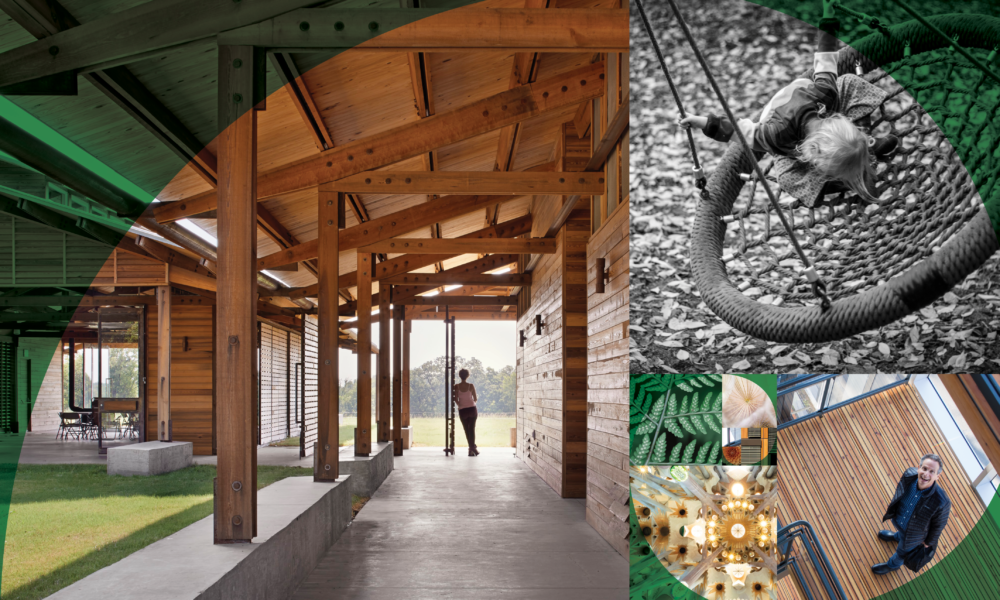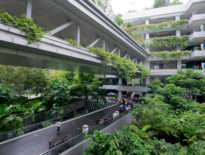New Release: Creating Biophilic Buildings
Amanda Sturgeon, FAIA, (CEO, International Living Future Institute) turns her award-winning eye for sustainable buildings toward biophilic design, an emerging design discipline that creates spaces where people and nature can thrive together as an integrated whole. Her new book from Ecotone Publishing, Creating Biophilic Buildings, takes a case study-style approach to this burgeoning field, using carefully curated examples to illuminate the holistic process of biophilic design and its benefits to both building occupants and nature.
“Biophilic design is a design philosophy, and has the potential to intentionally reconnect people and nature through buildings,” said Ms. Sturgeon. “It goes beyond adding plants or a water feature and focuses on connecting to the particular ecology of a place, to its culture and climate to create buildings that are full of life.”
The book includes 14 in-depth case studies, analyzes their strongest biophilic design attributes and details their design process and lessons learned. The late Stephen Kellert’s Biophilic Design framework is used to compare the projects against each other.
“In analyzing this group of projects against Kellert’s elements and attributes, I have come to appreciate even more how comprehensive and thoughtful the list is,” said Ms. Sturgeon. “The attributes cover the range of biophilic expression, from the basic human need for natural light and fresh air to our more complex emotional yearning to connect with our cultures, our histories and our environment.”
What is “Biophilic Design”?
Biophilic Design is the practice of creating spaces that connect people and nature. At its core, it is the reconciliation of people and nature in the built environment; observing how nature has survived for thousands of years and implementing the elements and attributes which have aided in nature’s survival despite the continuously changing environment. Just as nature is rooted in its land, Biophilic Design emphasizes the relationship to the land through enhancing geographic features, embodying the historical background, advocating for ecological restorations, and expressing the cultural connections to place.
About Author Amanda Sturgeon
Amanda Sturgeon, FAIA, is the CEO of the International Living Future Institute and the founder and driving force behind ILFI’s Biophilic Design Initiative and Transition Lab. Amanda is an award-winning architect who had a successful 15-year career as an architect working on some of the most sustainable buildings in the Pacific Northwest. In 2013 she was elected as a Fellow of the American Institute of Architects and became a LEED Fellow later the same year in recognition for her extensive advocacy and volunteer service to the green building movement. She was named as one of the top ten most powerful women in sustainability in 2015 as a recipient of the Women in Sustainability Leadership Award.
Amanda was born in the UK, educated in Australia, and now calls Bainbridge Island, WA, her home.
About Ecotone Publishing
Founded by green building experts in 2004, Ecotone Publishing is dedicated to meeting the growing demand for authoritative and accessible books on sustainable design, materials selection and building techniques in North America and beyond. Ecotone searches out and documents inspiring projects, visionary people and innovative trends that are leading the design industry to transformational change toward a healthier planet.
About International Living Future Institute
The International Living Future Institute is an environmental NGO committed to catalyzing the transformation toward communities that are socially just, culturally rich and ecologically restorative. ILFI is premised on the belief that providing a compelling vision for the future is a fundamental requirement for reconciling humanity’s relationship with the natural world. ILFI operates the Living Building Challenge, the built environment’s most rigorous performance standard, and Declare, an ingredients label for building materials. It houses the Cascadia Green Building Council and Ecotone Publishing.



